Key Takeaways
- Olympic Origins: Linnahall was constructed for the 1980 Moscow Olympics sailing events held in Tallinn, originally opening as the “V. I. Lenin Palace of Culture and Sports”. It was a multi-purpose venue with a 4,200-seat concert hall and an ice rink, symbolizing Soviet ambition to showcase Tallinn on the world stage.
- Architectural Significance: Designed by Estonian architects Raine Karp and Riina Altmäe, Linnahall’s monumental Brutalist form – broad stepped terraces of raw concrete – was the first development to truly connect Tallinn’s city center with the sea. Criticized by some for its massive scale, it nevertheless gained international attention and remains unique in the Baltic region. Its use of local materials and integration into the waterfront reflect a blend of Soviet modernism with Estonian context.
- Heyday and Decline: In the 1980s and 90s, Linnahall hosted everything from ice-hockey matches to concerts by world-famous artists. After Estonian independence in 1991, it continued as a civic hub (even hosting Western pop stars). However, chronic underinvestment led to rapid deterioration. The ice rink closed in 2009 and the concert hall shut in 2010 due to safety concerns. Since then, the interior has remained abandoned, its concrete terraces now weathered and graffiti-covered, accessible only informally.
- Preservation vs. Redevelopment: Linnahall was declared a protected heritage monument in 1997, but preservation has been fraught. Advocates like architectural historian Grete Tiigiste argue that the building’s striking form and cultural resonance make it worth saving for public use. “The fact that it affects so many is significant and something that we should preserve. The building is under heritage protection, so it is meant to be preserved,” Tiigiste noted in 2024. On the other side, city officials have floated plans to radically remake the area, even suggesting that reconstruction or demolition are on the table if restoration proves unviable. This clash between heritage conservation and development has made Linnahall a focal point of urban debate in Tallinn.
- Future Plans and Challenges: Recent proposals seek to transform the crumbling complex into a modern event center while integrating the harbor district into the city fabric. A vision unveiled by the Tallinn city government in late 2023 envisions Linnahall reborn as a concert and conference hall anchoring a new cultural quarter by the sea. The plan includes parks, a library, and pedestrian promenades linking the Old Town to the waterfront, essentially extending the city’s public space to the coast. Funding remains a challenge – earlier renovation plans (a ~€100 million project announced in 2017) stalled, and the new comprehensive plan is estimated at €330 million over ten years. Heritage authorities have also cautioned that Linnahall cannot simply be torn down without due process: its protected status cannot be revoked solely because the structure is in disrepair. Thus, any redevelopment must balance business goals with the site’s cultural value and legal protections.
- Hollywood Spotlight: In 2019, Linnahall found an unlikely new role as a film set. Director Christopher Nolan chose the cavernous hall to stand in for an opera house in Tenet, the 2020 sci-fi blockbuster. The movie’s opening siege scene – portrayed as taking place in Kyiv – was actually filmed inside Linnahall. This brought a flurry of positive attention to the long-closed venue. Nolan’s team had to make temporary repairs: they installed a new ventilation system, cleaned out mold and water damage, and even pulled up old carpets to accommodate filming. After Tenet’s release, thousands of locals and tourists flocked to special tours of Linnahall organized by the Estonian Architecture Centre to experience the “futuristic” building seen on screen. The Hollywood cameo reminded many Estonians of Linnahall’s iconic status and sparked fresh discussion about its potential.
Built for the 1980 Olympics: A Soviet-Era Ambition
The story of Linnahall begins with the 1980 Summer Olympics. While Moscow hosted those games, the sailing events were held in Tallinn – then part of the Estonian SSR – because landlocked Moscow had no suitable venue for yachting. The Soviet authorities seized the moment to invest in Tallinn’s infrastructure. Alongside a new Olympic Yachting Center at Pirita, they commissioned a grand concert and sports hall to commemorate the games and serve the local populace thereafter. That building opened in July 1980 as the Vladimir Ilyich Lenin Palace of Culture and Sports, bearing the Soviet leader’s name as a mark of ideological importance.
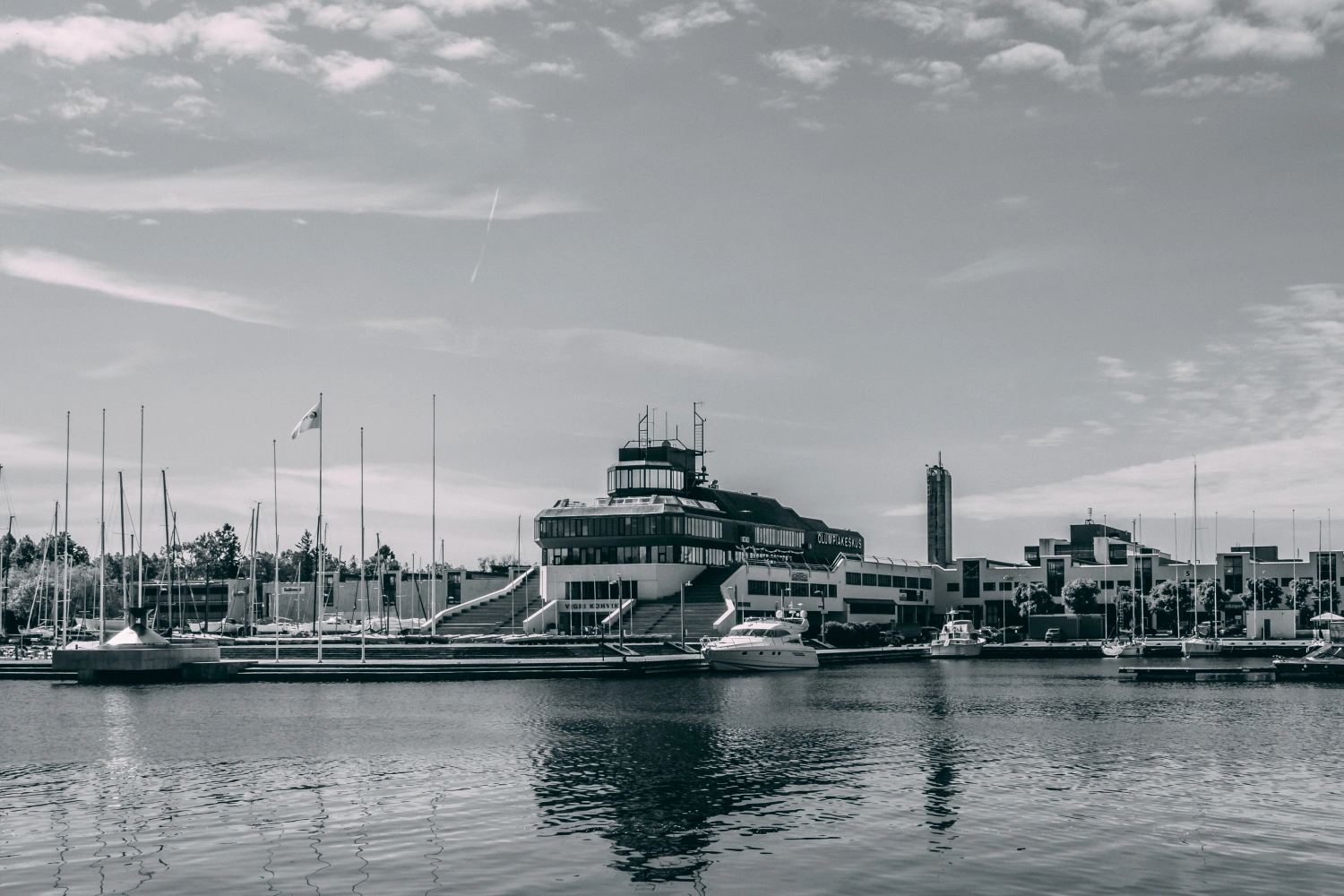
Architecturally, the project was entrusted to Estonians Raine Karp and Riina Altmäe, who delivered a design quite unlike typical Soviet halls. Linnahall (as it was later renamed) resembles a brutalist ziggurat – a low concrete pyramid with wide staircases ascending its flanks. Its footprint sprawls along the harbor, forming a massive podium that appears to rise out of the ground. This was no coincidence: Karp intended the structure to link Tallinn’s medieval Old Town, which had long been separated from the shore by industrial areas, back to the Baltic Sea. For the first time in centuries, Tallinn had a public promenade to the water, via Linnahall’s rooftop terraces that function as walkable ramps toward the sea.
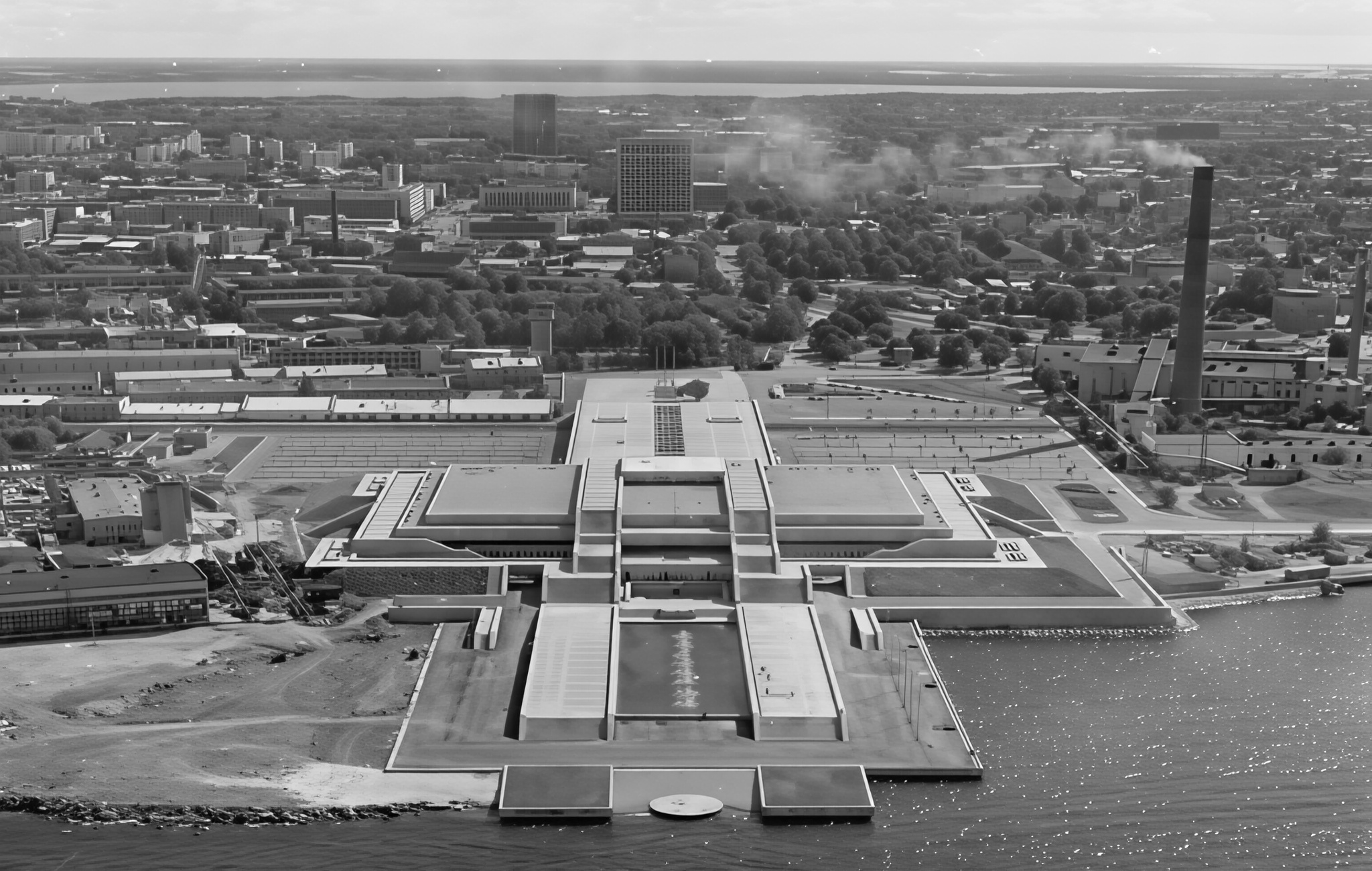
VIDEO: Estonian cultural segment from theat the 1980 Olympic Games opening ceremony dancing "Tuljak" - 39:40 - Cultural Segment: Dance of Estonia SSR
-gigapixel-wonder-2x.avif)
In form and materials, Linnahall exemplified late Soviet modernism tempered by local context. The exterior was largely raw concrete – characteristic of Brutalist architecture – yet the use of Estonian limestone and other local materials in parts of the structure gave it regional identity. Its interior featured a 5,000-seat arena that could host both concerts and sporting events, plus an Olympic-size ice rink beneath the same roof.
-gigapixel-wonder-2x.avif)
In fact, sports were a major focus in the planning: “When the Linnahall was planned, the role of sports was actually more important than concert activities,” notes Grete Tiigiste, who studied the building’s history. The stage was designed to convert into a basketball court, and at various times officials floated ideas from a boxing ring to an ice-hockey arena inside. Ultimately the hall became a multi-use venue – during the Olympics it supported sailing award ceremonies and cultural programs, and afterwards it was adaptable for everything from figure skating shows to pop concerts.
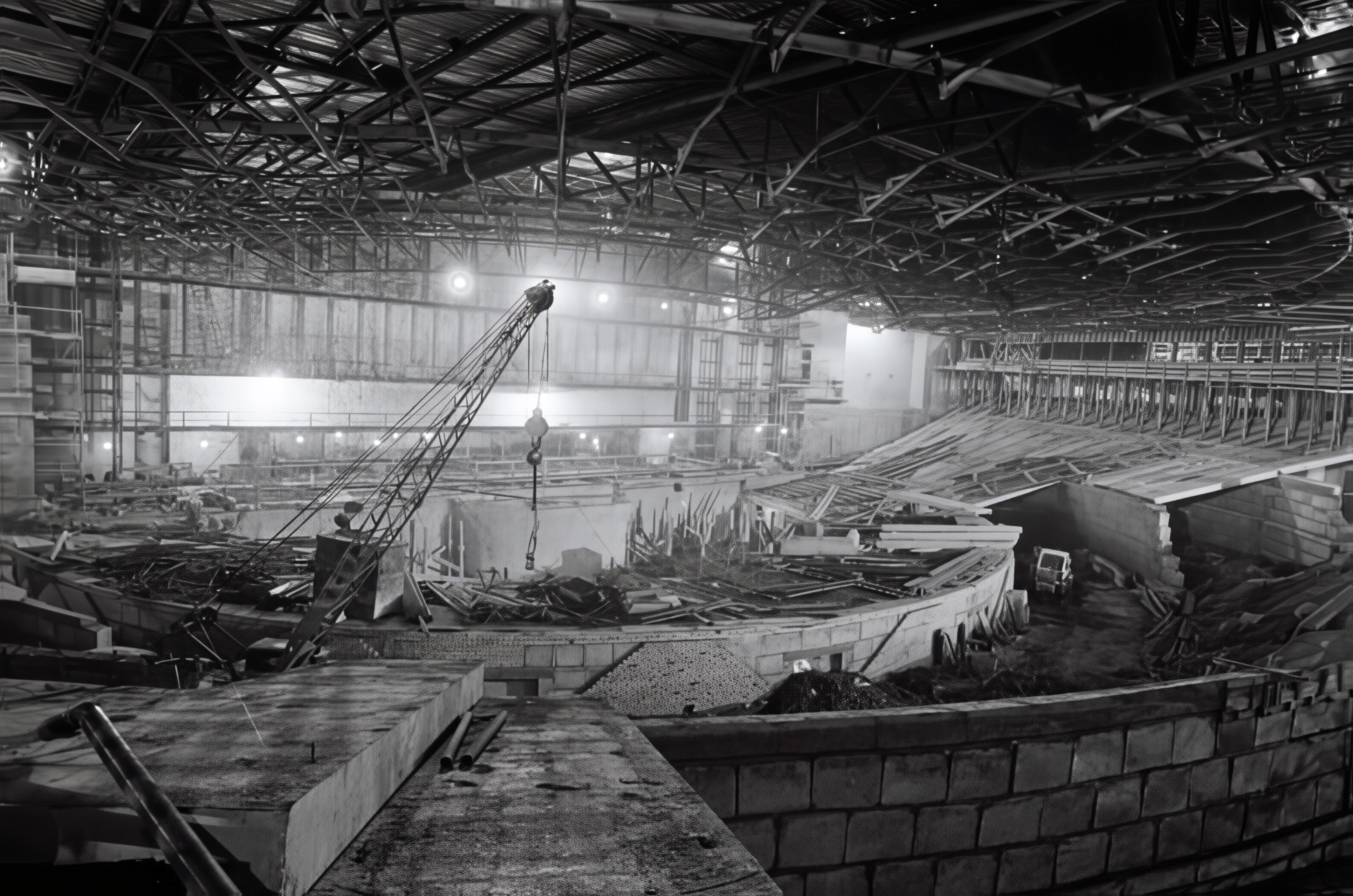
Upon its opening, the Lenin Palace of Culture and Sports was a source of local pride. It was one of the largest public buildings ever built in Estonia, showcasing the republic’s architectural talent on an international stage. Yet it also embodied the contradictory nature of Soviet investment – monumental and imposing, meant to project power. Some residents found its concrete severity jarring next to the Hanseatic charm of Old Town. Others praised it as boldly modern. This split opinion has only intensified over time, as we will see. But in 1980, few could deny that Linnahall symbolized a new era for Tallinn’s urban landscape, one literally breaking the wall between city and sea.
A Cultural Hub in Decay: Linnahall’s Rise and Fall
For the first two decades of its life, Linnahall fulfilled the purpose implied in its name – a palace of culture and sports for the people. In the 1980s, it hosted Communist Party congresses and state ceremonies under Soviet rule, but also rock concerts, ballet performances, and sporting tournaments. After Estonia regained independence in 1991, the venue shed Lenin’s name and simply became Tallinna Linnahall (“Tallinn City Hall”). It quickly transformed into a democratic gathering place. International artists included pop and rock icons – from Duran Duran and Lou Reed to Celine Dion – who drew huge audiences in the 1990s when Estonia was newly open to the West. On winter days, families would ice-skate in its rink by the harbor; on New Year’s Eve, crowds would sometimes watch fireworks from its broad steps. Linnahall had entrenched itself in the city’s collective memory as a venue of shared experiences.
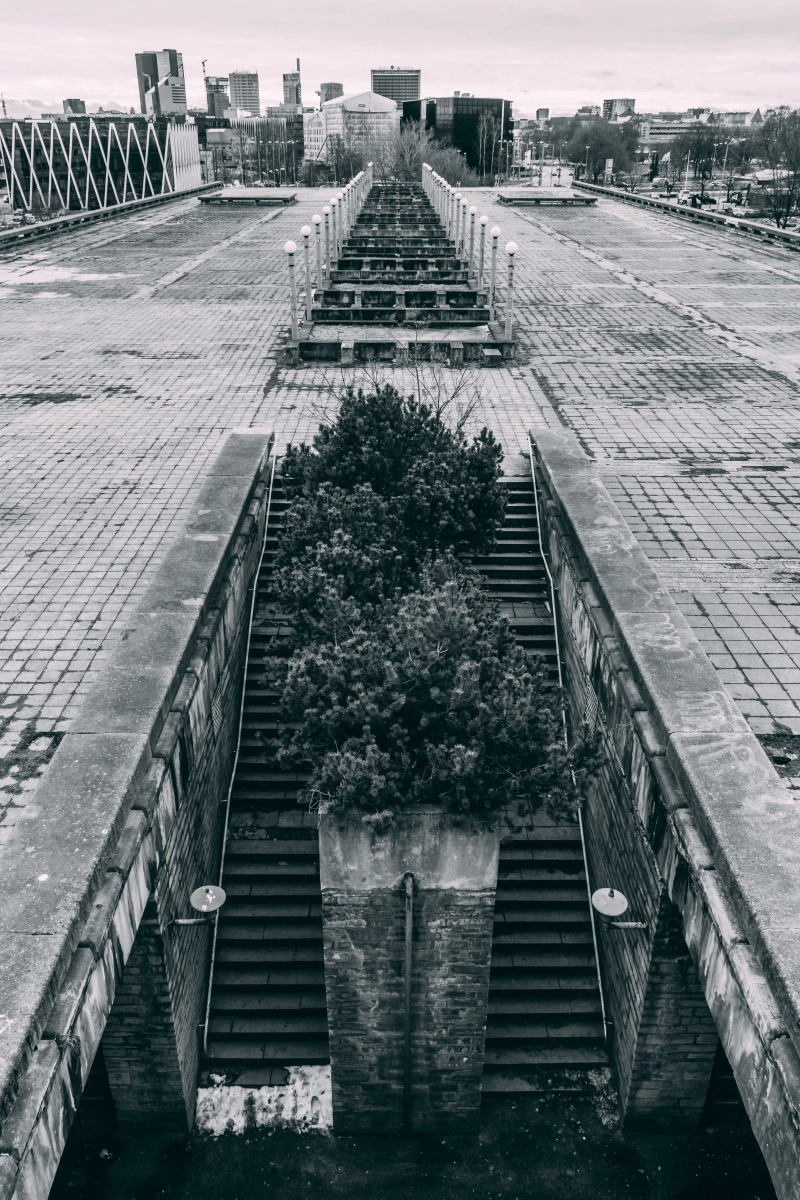
However, by the 2000s, the cracks – both literal and figurative – were showing. Built quickly with late-1970s Soviet materials, the structure was aging poorly. Water leaked through concrete joints and the salt air corroded fixtures. Successive city governments struggled to fund major repairs for such a colossal building in lean post-Soviet times. Basic maintenance was done sparingly. Even as Linnahall remained busy with events, behind the scenes its technical systems (heating, ventilation, electrical) grew outdated. In 2009 the aging ice hall was shut down, and by 2010 the main auditorium was closed as well, deemed unsafe for public use. The doors were locked, and Linnahall entered what has become a 15-year period of dormancy.
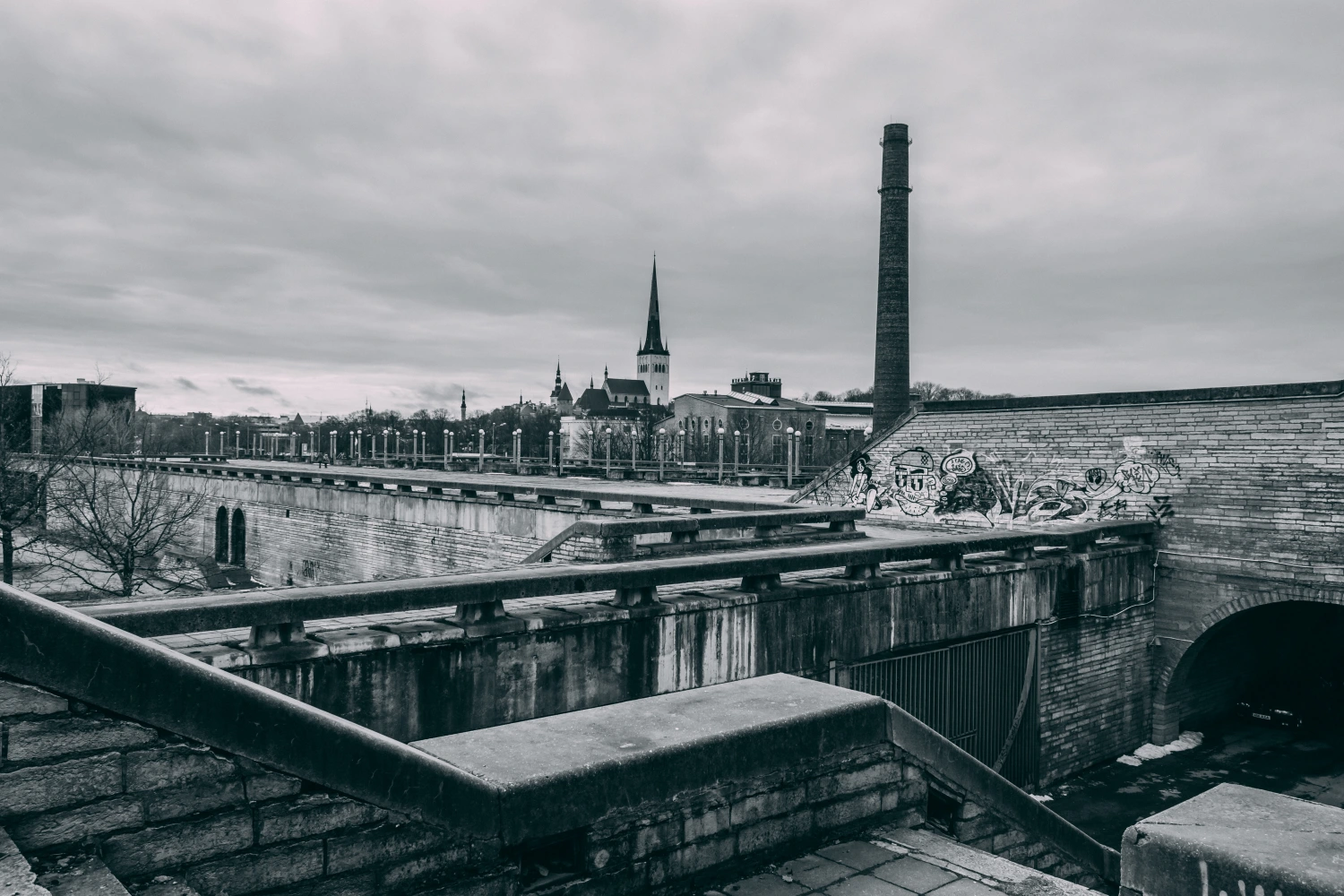
What happens when a huge concrete landmark goes dormant? In Linnahall’s case, it has become a sort of modern ruin. Weeds sprout between the paving stones of its once-grand plaza. Nearly every accessible surface is tagged with graffiti. The only regular visitors have been adventurous locals, skaters, and tourists in search of “urban exploration” photos. A heliport and a small marina adjacent to Linnahall continued to operate through the 2010s, and a café opened briefly on the seaward side, but the building’s interior sat dark and silent. Despite being out of use, the structure’s sheer bulk keeps it ever-present on the waterfront – a constant reminder of the past.
-gigapixel-standard-max-2x.avif)
It’s worth noting that even as the building decayed, it wasn’t forgotten. In 1997, Linnahall was officially listed as a protected heritage monument, recognizing its architectural and cultural value. This status has meant that any alterations require approval from heritage authorities, which partly explains the long impasse: renovating a protected Brutalist landmark is complex and expensive. The longer the stalemate dragged on, the more Linnahall became a target of frustration. Local architect Margit Mutso bluntly opined in 2023 that “Tallinn has done all it can to ensure Linnahall stays dilapidated,” suggesting that the city’s inaction was deliberate to justify redevelopment on its own terms. While harsh, her critique underscores public cynicism that the hall was essentially allowed to rot.
To Preserve or Transform? The Battle Over Linnahall’s Future
In recent years, Linnahall’s fate has become one of Tallinn’s hottest urban planning issues. Broadly, two camps have emerged:
- Preservationists argue that Linnahall is an irreplaceable piece of Estonia’s 20th-century heritage – a rare example of ambitious Soviet-era architecture on Estonian soil – and should be preserved and repurposed, not destroyed. Many in this camp acknowledge the building needs a new use, but insist that any development honor the original structure. Grete Tiigiste, an architectural historian who co-curated the “Linnahall Forever” exhibition in 2024, is a voicing here. She emphasizes the hall’s unique design and emotional resonance: “Its large-scale form – much criticized on one hand, but incredibly solid and eye-catching on the other – has attracted a lot of international attention. The fact that it affects so many is significant…The building is under heritage protection, so it is meant to be preserved,” Tiigiste explains. Preservationists envision a restored Linnahall as a mixed-use cultural hub – perhaps a venue for concerts, community sports (reviving the ice rink), galleries, or a museum – that would allow the public to enjoy the space again while keeping its historical character intact. They point out that Linnahall was conceived as a people’s palace and should remain in the public realm rather than be replaced by private real estate.
- Redevelopers/Modernizers contend that Linnahall’s current state is beyond practical salvation and that clinging to it hinders Tallinn’s progress. From this view, the site – a large parcel of city-owned land by a growing harbor – is too important to lie fallow. City authorities have drafted multiple plans to overhaul the area with new functions. Notably, in 2017 the Tallinn City Council approved a plan (never realized) to renovate Linnahall into an international conference center and concert hall, leveraging public and private funds. After that stalled, a new vision unveiled in late 2023 takes an even more expansive approach: it divides the Linnahall property and adjacent lands into four zones, proposing not just a revamped hall but also business buildings, a new library, parks, a winter swimming center, and even a small harbor for ferries to nearby islands. Crucially, this 2023 plan does not guarantee Linnahall’s preservation – it suggests the building could be “completely reconstructed or demolished” if needed, in order to achieve a “modern event center” that opens the city to the sea. City leaders like Mayor Mihhail Kõlvart frame the goal as reconnecting historic Tallinn with its waterfront: “Linnahall once served as a bridge to the sea; according to the new vision, it’s not just one structure leading to the sea but opening the Old Town and city center to the sea as a whole through public spaces and street networks,” Kõlvart said in 2023. To proponents of redevelopment, replacing or radically rebuilding Linnahall (while perhaps retaining a symbolic fragment) could create a thriving coastal quarter that benefits the economy and public life more than a decaying monument does.
The divide between these positions has been sharpened by practical realities. A full restoration of Linnahall has been estimated to cost on the order of €100–200 million – a daunting sum for the city. Private investors have shown interest periodically, but deals fell through when costs and heritage restrictions were fully understood. Meanwhile, Estonia’s National Heritage Board has stood firm that Linnahall’s protected status cannot be removed just because the building is in bad shape. “We have heard arguments that the building is in such a bad state that it makes no sense to rebuild it… But the justification that it is in poor repair is not a basis for removing the building’s status as a listed building,” said Marilin Mihkelson, the Heritage Board’s director, when surprised by the city’s 2023 announcement. In other words, unless the government formally de-lists the site (a complex legal process likely to spark public outcry), demolition is off the table. This has forced the city to adopt a more nuanced tone, saying they will study all options. As of 2025, a detailed plan is being drafted and architectural competitions are envisioned to determine what a renewed Linnahall or its replacement might look like.
.jpg)
The controversy boils down to how Tallinn defines itself. To many locals, Linnahall is not “beautiful” in a traditional sense – it’s often called an eyesore and compared to a bunker. Yet it is their eyesore, a piece of lived history from a complex era. It also represents the broader theme of post-Soviet cities grappling with Soviet architectural legacies: do you erase them for sleek new development, or adapt them as meaningful reminders of the past? Estonia, being a small nation that endured occupation, is especially sensitive to preserving its story. This perhaps explains why even younger generations have joined calls to save Linnahall, seeing value in its Brutalist aesthetic and its potential to be, once again, a community space. The coming years will likely see a compromise of some sort – perhaps a contemporary redesign that keeps Linnahall’s shell – but the outcome is still uncertain.
A Cinematic Reprieve: Tenet and Public Imagination
While city plans and heritage debates evolved slowly, an unexpected event gave Linnahall a burst of life in June 2019: the arrival of a Hollywood film crew. Christopher Nolan’s Tenet was a huge production that chose Tallinn as a key filming location, and Linnahall was selected to portray the interior of an opera house in the movie’s opening action sequence. For a building shuttered nearly a decade, this was both bizarre and exciting. Nolan, known for appreciating striking architecture, presumably found Linnahall’s colossal, time-worn interior perfect for the film’s atmosphere.
.jpg)
The filming required making parts of Linnahall temporarily functional again. According to tour guides, Estonia’s health authorities had initially only approved 15-minute shoots inside due to mold and stale air, forcing Nolan’s team to intervene. Over several weeks, the crew repaired Linnahall’s ventilation system and cleaned the interior, removing years of dust and replacing musty carpeting. These modest improvements actually extended the building’s life – slowing down water damage and airing out the moldy halls. Locals were delighted to hear that something was happening inside those concrete walls, even if it was just movie magic. Dozens of Estonian extras were hired, and explosions and gunfire echoed within during the filming of the fictional terrorist siege scene. Nolan’s secrecy meant few images emerged until the film’s release, but the mere fact that Linnahall was involved became a talking point in Tallinn.
When Tenet hit cinemas in 2020, there was global buzz about its Estonian locations. Moviegoers saw Linnahall’s distinctive interior on the big screen (masquerading as “Kyiv Opera House”), introducing millions to this obscure landmark. Due to the COVID-19 pandemic, the hoped-for spike in tourism was muted, but Tallinn’s tourism office still created a special “Tenet Tour” map guiding visitors to Linnahall and other filming spots. And indeed, as soon as local lockdowns eased, people started coming. Over 3,000 people attended architecture tours of Linnahall in late 2020 to peek inside the grand hall that Nolan had briefly revived. Architecture enthusiasts and film fans alike were awed by the “time capsule” feel of the interior – the Soviet acoustics, the drip of rainwater through the roof, and now the lingering aura of Hollywood. For many younger Estonians, this was their first-ever entry into Linnahall’s auditorium.
.jpg)
The Tenet episode did not directly save Linnahall, but it showed a glimpse of what could be. One could imagine the hall permanently filled with music and audiences again – or serving some creative new purpose – rather than being left to slowly crumble. As one Reddit user quipped after touring the site, “Man, they gotta save Linnahall. It looks so futuristic and way ahead of its time!”. The temporary improvements by Nolan’s crew allowed more public tours to continue into 2021–2022, giving decision-makers proof that interest in the building is alive. It also proved that even in disrepair, Linnahall can inspire; it became a character in a story, not just a relic. This boost to public imagination may yet influence the final outcome – at the very least, it reminded everyone that once upon a time Linnahall was a functioning venue that brought joy to people’s lives.
.jpg)
Legacy and Significance: An Enduring Symbol of an Era
As Tallinn advances further into the 21st century, Linnahall stands at a crossroads of history, architecture, and urban identity. Its significance extends beyond the physical concrete and rebar. For Estonians, especially those who grew up in the late Soviet period, Linnahall embodies a complex legacy: it was built by an occupying regime yet designed by local architects; it was meant to impress Moscow’s elites yet ended up serving ordinary Tallinn residents for decades. In this way, the building is a tangible piece of the national story – a reminder of how Estonians navigated a foreign system and still managed to leave their mark (quite literally, Karp’s design was a quiet act of creative rebellion against Soviet architectural uniformity). Keeping Linnahall in the landscape, in whatever form, anchors the memory of that era in the modern city.
Within the broader Soviet architectural canon, Linnahall is also noteworthy. The late 1970s saw few projects of such scale in the smaller Soviet republics. It wasn’t a typical prefabricated drab structure; it was an ambitious civic building that combined a brutalist aesthetic with multi-functionality. Some have called it “a monument caught between past and possibility,” encapsulating how Soviet monuments can be reinterpreted in the present. Indeed, Linnahall’s story echoes that of similar structures across Eastern Europe – many have faced demolition, others have found new life as concert arenas, art galleries, or conference centers after extensive retrofitting. What sets Linnahall apart is its seaside context and its pyramid-like form that invites people to climb and linger. It always was a bit of a public plaza as much as a building. Any future redevelopment would do well to preserve that spirit of openness.
As of 2025, the question “What should we do with Linnahall?” is on the minds of city officials, conservationists, and citizens alike. A new detailed plan is in the works, and stakeholders from heritage experts to private developers will have their say. The outcome is hard to predict – it may be a fully restored cultural center, a hybrid new structure retaining parts of the old, or in the most drastic scenario, an entirely new building that pays homage to Linnahall’s memory. But one thing is certain: the debate itself has underlined just how significant Linnahall is in Estonia’s architectural landscape. A building once dismissed as a Soviet white elephant is now appreciated (even loved) for the very qualities that make it unconventional.
In the words of Tallinn’s Heritage Board, “the building is under heritage protection, so it is meant to be preserved.”news.err.ee Whether Linnahall’s concrete walls remain standing or not, that ethos of **preservation – of acknowledging the layers of history in the city fabric – will guide the next chapter. And perhaps in a few years, Tallinn’s residents will once again ascend those monumental steps to enjoy a seaside concert or skate on a revived rink, experiencing the revival of a space that has always bridged the city’s past and future.
-gigapixel-wonder-4x.jpg)













.png)
.png)
.png)
